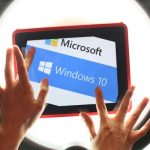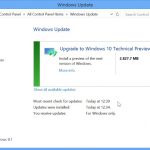Left behind by the Windows 10 bandwagon

I consider myself a patient person. After more than 25 years in the IT industry you sort of have to be. When I bought my first real hybrid 2-in-1 PC -- an HP Envy x2 -- I learned to put up with the many quirks of the then brand-new Windows 8. And when Windows 8.1 arrived, I tolerated several weeks of display artifacts and other graphical anomalies, confident that they would all get sorted out -- eventually.
Which they did. In fact, for each case a new round of device drivers -- specifically, for the Envy x2’s Atom Z2760 chipset and associated Graphics Media Accelerator (GMA) video subsystem -- cured what ailed it. So it’s understandable that I would expect a similar scenario to play out with Windows 10. After all, Microsoft’s new OS is really just a retread of Windows 8 (which was itself a retread of Windows 7, etc.). And my trusty Envy x2 excels at running Windows 8.1.
Hate Windows 10? You still have a year to buy a Windows 7 PC

The adoption of Windows 10 is slowing, and that trend is set to continue -- largely thanks to Microsoft. In an unusual move, the company has extended the availability of Windows 7 so it will be possible to buy computers with the operating system pre-installed until the end of October next year.
What's particularly interesting about this is that it means that Windows 7 will be available to buy for longer than Windows 8. Many would take this as an admission of the widespread dislike for Windows 8, but it also offers a lifeline to anyone who wants a new computer without Windows 10.
Remove unwanted Windows 10 upgrade files from Windows 7 and Windows 8.x

Microsoft has reportedly been downloading Windows 10 installation files on to computers running Windows 7 and 8.x, regardless of whether the users plan to upgrade to the new OS or not.
If you’re thinking of making the switch, and have requested an upgrade, that is fair enough. But if you’re more than happy to stick with your older OS for now, you might not be too happy about Microsoft cluttering up your hard drive with junk install files you don’t want. Fortunately, removing these files is easy enough.
8GadgetPack brings gadgets back to the Windows 10 desktop

Windows gadgets made their first appearance in Vista as a convenient way to install tiny desktop tools like clocks, system monitors or weather applets.
The technology was retired in 2012 due to security vulnerabilities, but these days any danger is minimal, and if you were a fan then 8GadgetPack provides an easy way to run more than 50 gadgets on Windows 8, 8.1 and 10 PCs.
Amid Windows 10 controversy, Microsoft quietly releases privacy botching features to Windows 7 and 8

It's been roughly a month since the release of Windows 10, Microsoft's newest desktop operating system. It packs in several enticing features including the digital assistant Cortana. But despite all the interesting offerings, Windows 10 isn't sitting well with many. Privacy advocates have criticized Microsoft for introducing several features that are seemingly concerning to those who care about their privacy. To make things worse, the company has now rolled out some of these annoying features to Windows 7 and Windows 8.
First spotted by Ghacks, some of the recent updates that Microsoft rolled out to Windows 8 and Windows 7 set a computer to regularly send reports of a machine's activities to Microsoft. The update dubbed 3068708, for instance, introduces the Diagnostics and Telemetry tracking service on the computers it is installed on. "By applying this service, you can add benefits from the latest version of Windows to systems that have not yet upgraded. The update also supports applications that are subscribed to Visual Studio Application Insights", Microsoft describes the purpose of the update.
Ha-ha! Windows 10 is already twice as popular as Windows 8

The last lot of desktop OS figures released by NetMarketShare showed that Windows 10 had doubled its usage shared in a matter of days, but it wasn’t exactly an exciting number. Upon release the new OS managed to go from 0.16 percent to 0.39 percent.
But now that Windows 10 has had a month to settle in, we can finally see exactly how well it’s doing. Microsoft has said that there have been over 75 million installs, but what does that equate to in terms of usage share? NetMarketShare’s figures for August always promised to be exciting, and they definitely don’t disappoint now that they’re here.
How to find your Windows 10 product key

If you upgrade your computer from Windows 7 or Windows 8 to Windows 10, you probably have no idea what your product key is for the latest version of the operating system. The time may come when you want to perform a clean installation of Windows 10, and this is when you'll need that key.
It is not possible to use your product key for your old version of Windows to activate Windows 10, but during the initial upgrade process this key is converted into a new one. Using a special tool, you can find out the key that has been generated for you so you can make a note of it for future reference.
Upgrade to Windows 10 and your kids may no longer be safe

Parents who are upgrading their computers to Windows 10 are warned that the move from Windows 7 or Windows 8.1 will obliterate the safety features used to protect children. You may have spent time putting restrictions in place in a bid to keep your offspring safe when using your computer, but Windows 10 will change these child-friendly accounts into standard accounts with no limitations whatsoever.
The upgrade process wipes out website restrictions, game and app age ratings, time limits, and other parental controls and monitoring options. Unless a parent goes to the trouble of reinstating each of these settings individually, their children will have unfettered computer access. The discovery, revealed by The Register, will come as a surprise to many, but the worry is that many parents will simply be unaware that their children are not protected. And this is far from being the first time Windows 10 has been criticized.
Windows 10 doubles its usage share in a couple of days

NetMarketShare has released its monthly desktop operating system usage share figures, showing the fluctuations of the various iterations of Windows. All versions of Microsoft’s operating system registered drops in July, except of course Windows 10 which was launched at the tail end of the month.
Only being available for a few days meant the new OS was never going to shift the needle significantly, but there were enough upgraders (Microsoft says 14 million in the first 24 hours) to double the operating system’s share.
Microsoft releases emergency security patch for all Windows versions

Microsoft has released an off-schedule patch for all currently supported versions of Windows. A serious vulnerability has been discovered in a font driver that could be exploited by a hacker to remotely execute code on a compromised machine.
The problem affects Vista, Windows 7, Windows 8, Windows 8.1, Windows RT, Windows RT 8.1, Windows Server 2008, and Windows Server 2012. Windows 10 is not at risk. Microsoft describes the issue as 'critical' and has pushed an emergency patch to Windows Update.
Windows 7 gains significant usage share ahead of Windows 10 launch

Windows 8.x enjoyed a good month in May. The tiled operating system finally overtook Windows XP for the first time in six months -- its gains coming mostly at the expense of Windows 7. But it was all change again in June according to the latest usage stats from web analytics firm NetMarketShare.
The latest figures show Windows 8.x losing share -- or business as usual you might say -- going from 16.63 percent to 16.02 percent. That’s a drop of 0.61 percentage points. Windows 8.1 actually gained 0.24 percentage points, but Windows 8 lost 0.85 percentage points. Still overall it remains comfortably ahead of XP now, so there's that consolation prize.
How to upgrade from Windows 7 or 8 to Windows 10 via Windows Update

If you like the idea of trying out the next version of Windows before it is officially launched, Microsoft has made the Windows 10 Technical Preview available for everyone to use. There are various ways to get the preview installed on your computer, but since the release of build 9926, it is possible to upgrade your current Windows 7 or Windows 8 installation to Windows 10 using Windows Update.
This is a much simpler option than downloading the ISO image, but it is an upgrade route that almost encourages people to install the preview build on their everyday computer -- don’t forget that this is not a finished product! We've already looked at how to install Windows 10 in a virtual machine, but if you have a spare machine running Windows 7 or 8, using it as a test bed for Windows 10 just got a whole lot easier.
It really is game over for Windows 8.x

Every month NetMarketShare releases usage share figures for all of the major operating systems. In the past these figures tended to paint an interesting picture of how well -- or rather how badly -- Microsoft’s newest operating system was doing. Occasionally the OS grew share, occasionally it lost share -- sometimes quite dramatically.
Now though, the only picture that’s being painted by these monthly figures is an operating system that has no future and will vanish quietly, and with zero fanfare, once Windows 10 arrives.
Fujitsu and Microsoft announce IoT and M2M partnership

Much of the focus of talk about the Internet of Things surrounds what the IoT can do for home users. A clever cooker is great, but move up the scale a little, however, and things start to get really interesting. Now teaming up with Miele, Microsoft today announces that it is also partnering with Fujitsu.
The two companies will work together to create IoT based devices to improve the manufacturing of other products. By harnessing the power of IoT and the M2M (machine to machine) platforms, Microsoft and Fujitsu aim to improve production efficiency and help drive down costs.
Windows 8.x still nowhere near as popular as Windows XP

It’s fair to say, Windows 8.x has enjoyed something of a rollercoaster ride when it comes to usage share. While it’s never been a popular operating system (quite the opposite in fact), share has gone up and down, with gains one month being wiped out by losses the following month.
NetMarketShare’s monthly usage share figures provide a decent guide as to how Microsoft’s tiled OS is doing, and it’s usually pretty interesting, although February was a fairly unexciting month.
Recent Headlines
Most Commented Stories
BetaNews, your source for breaking tech news, reviews, and in-depth reporting since 1998.
© 1998-2025 BetaNews, Inc. All Rights Reserved. About Us - Privacy Policy - Cookie Policy - Sitemap.